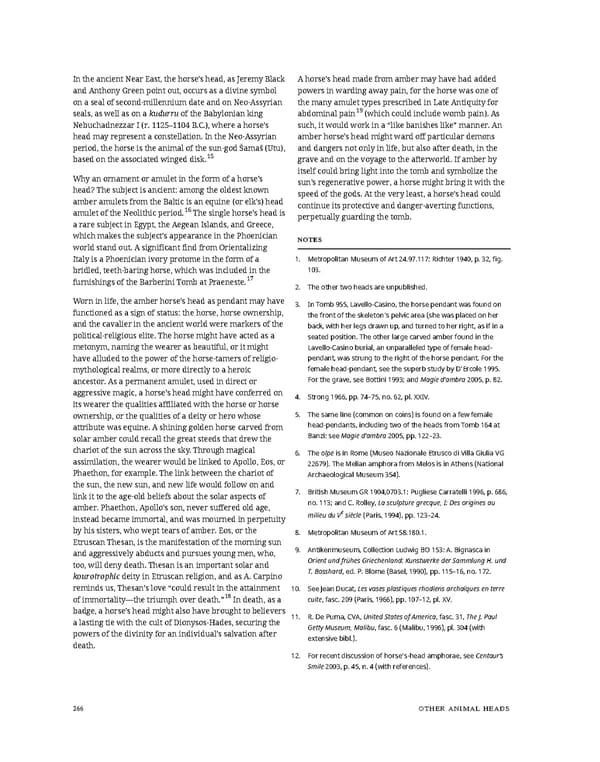In the ancient Near East, the horse’s head, as Jeremy Black A horse’s head made from amber may have had added and Anthony Green point out, occurs as a divine symbol powers in warding away pain, for the horse was one of on a seal of second-millennium date and on Neo-Assyrian the many amulet types prescribed in Late Antiquity for seals, as well as on a kudurru of the Babylonian king abdominal pain19(which could include womb pain). As Nebuchadnezzar I (r. 1125–1104 B.C.), where a horse’s such, it would work in a “like banishes like” manner. An head may represent a constellation. In the Neo-Assyrian amber horse’s head might ward off particular demons period, the horse is the animal of the sun-god Šamaš (Utu), and dangers not only in life, but also after death, in the based on the associated winged disk.15 grave and on the voyage to the afterworld. If amber by itself could bring light into the tomb and symbolize the Why an ornament or amulet in the form of a horse’s sun’s regenerative power, a horse might bring it with the head? The subject is ancient: among the oldest known speed of the gods. At the very least, a horse’s head could amber amulets from the Baltic is an equine (or elk’s) head continue its protective and danger-averting functions, amulet of the Neolithic period.16 The single horse’s head is perpetually guarding the tomb. a rare subject in Egypt, the Aegean Islands, and Greece, which makes the subject’s appearance in the Phoenician NOTES world stand out. A significant find from Orientalizing Italy is a Phoenician ivory protome in the form of a 1. Metropolitan Museum of Art 24.97.117: Richter 1940, p. 32, fig. bridled, teeth-baring horse, which was included in the 103. furnishings of the Barberini Tomb at Praeneste.17 2. The other two heads are unpublished. Worn in life, the amber horse’s head as pendant may have 3. In Tomb 955, Lavello-Casino, the horse pendant was found on functioned as a sign of status: the horse, horse ownership, the front of the skeleton’s pelvic area (she was placed on her and the cavalier in the ancient world were markers of the back, with her legs drawn up, and turned to her right, as if in a political-religious elite. The horse might have acted as a seated position. The other large carved amber found in the metonym, naming the wearer as beautiful, or it might Lavello-Casino burial, an unparalleled type of female head- have alluded to the power of the horse-tamers of religio- pendant, was strung to the right of the horse pendant. For the mythological realms, or more directly to a heroic female head-pendant, see the superb study by D’Ercole 1995. ancestor. As a permanent amulet, used in direct or For the grave, see Bottini 1993; and Magie d’ambra 2005, p. 82. aggressive magic, a horse’s head might have conferred on 4. Strong 1966, pp. 74–75, no. 62, pl. XXIV. its wearer the qualities affiliated with the horse or horse ownership, or the qualities of a deity or hero whose 5. The same line (common on coins) is found on a few female attribute was equine. A shining golden horse carved from head-pendants, including two of the heads from Tomb 164 at solar amber could recall the great steeds that drew the Banzi: see Magie d’ambra 2005, pp. 122–23. chariot of the sun across the sky. Through magical 6. Theolpeis in Rome (Museo Nazionale Etrusco di Villa Giulia VG assimilation, the wearer would be linked to Apollo, Eos, or 22679). The Melian amphora from Melos is in Athens (National Phaethon, for example. The link between the chariot of Archaeological Museum 354). the sun, the new sun, and new life would follow on and link it to the age-old beliefs about the solar aspects of 7. British Museum GR 1904,0703.1: Pugliese Carratelli 1996, p. 686, amber. Phaethon, Apollo’s son, never suffered old age, no. 113; and C. Rolley, La sculpture grecque, I: Des origines au milieu du Ve siècle (Paris, 1994), pp. 123–24. instead became immortal, and was mourned in perpetuity by his sisters, who wept tears of amber. Eos, or the 8. Metropolitan Museum of Art 58.180.1. Etruscan Thesan, is the manifestation of the morning sun and aggressively abducts and pursues young men, who, 9. Antikenmuseum, Collection Ludwig BO 153: A. Bignasca in too, will deny death. Thesan is an important solar and Orient und frühes Griechenland: Kunstwerke der Sammlung H. und kourotrophic deity in Etruscan religion, and as A. Carpino T. Bosshard, ed. P. Blome (Basel, 1990), pp. 115–16, no. 172. reminds us, Thesan’s love “could result in the attainment 10. See Jean Ducat, Les vases plastiques rhodiens archaïques en terre of immortality—the triumph over death.”18 In death, as a cuite, fasc. 209 (Paris, 1966), pp. 107–12, pl. XV. badge, a horse’s head might also have brought to believers 11. R. De Puma,CVA,United States of America, fasc. 31, The J. Paul a lasting tie with the cult of Dionysos-Hades, securing the Getty Museum, Malibu, fasc. 6 (Malibu, 1996), pl. 304 (with powers of the divinity for an individual’s salvation after extensive bibl.). death. 12. For recent discussion of horse’s-head amphorae, see Centaur’s Smile 2003, p. 45, n. 4 (with references). 266 OTHER ANIMAL HEADS
 Ancient Carved Ambers in the J. Paul Getty Museum Page 275 Page 277
Ancient Carved Ambers in the J. Paul Getty Museum Page 275 Page 277